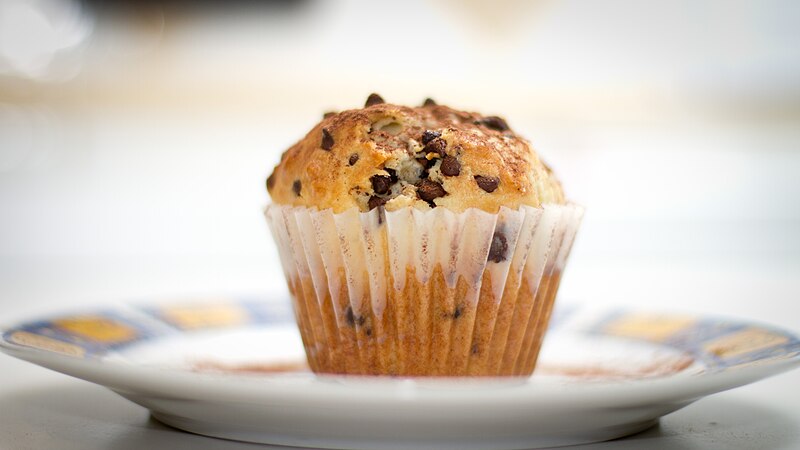File:Profile of muffin (5398771984).jpg

Original file (5,184 × 2,916 pixels, file size: 1.93 MB, MIME type: image/jpeg)
Captions
Captions
| DescriptionProfile of muffin (5398771984).jpg |
Recipes for muffins, in their yeast-free "American" form, are common in 19th century American cookbooks. Recipes for yeast-based muffins, which were sometimes called "common muffins" or "wheat muffins" in 19th century American cookbooks, can be found in much older cookbooks. A somewhat odd combination of circumstances in the 1970s and 1980s led to significant changes in what had been a rather simple, if not prosaic, food. The decline in home-baking, the health food movement, the rise of the specialty food shop, and the gourmet coffee trend all contributed to the creation of a new standard of muffin. Preservatives in muffin mixes led to the expectation that muffins did not have to go stale within hours of baking, but the resulting muffins were not a taste improvement over homemade. On the other hand, the baked muffin, even if from a mix, seemed almost healthy compared to the fat-laden alternatives of doughnuts and Danish pastry. "Healthy" muffin recipes using whole grains and such "natural" things as yogurt and various vegetables evolved rapidly. But for "healthy" muffins to have any shelf-life without artificial preservatives, the sugar and fat content needed to be increased, to the point where the "muffins" are almost indistinguishable from cupcakes. The rising market for gourmet snacks to accompany gourmet coffees resulted in fancier concoctions in greater bulk than the original, modestly sized corn muffin. The marketing trend toward larger portion sizes also resulted in new muffin pan types for home-baking, not only for increased size. Since the area ratio of muffin top to muffin bottom changed considerably when the traditional small round exploded into a giant mushroom, consumers became more aware of the difference between the soft texture of tops, allowed to rise unfettered, and rougher, tougher bottoms restricted by the pans. There was a brief foray into pans that could produce "all-top" muffins, i.e., extremely shallow, large-diameter cups. The TV sitcom Seinfeld made reference to this in the "The Muffin Tops" episode in which the character Elaine Benes co-owns a bakery named "Top o' the Muffin to You!" that sold only the muffin tops. Along with the increasing size of muffins is a contrary trend of extremely small muffins. It is now very common to see muffin pans or premade muffins that are only one or two inches in diameter. en.wikipedia.org/wiki/Muffin |
| Date | |
| Source | Muffin - IMG_0246 |
| Author | N i c o l a from Fiumicino (Rome), Italy |
Licensing edit
- You are free:
- to share – to copy, distribute and transmit the work
- to remix – to adapt the work
- Under the following conditions:
- attribution – You must give appropriate credit, provide a link to the license, and indicate if changes were made. You may do so in any reasonable manner, but not in any way that suggests the licensor endorses you or your use.
| This image was originally posted to Flickr by Nicola since 1972 at https://www.flickr.com/photos/15216811@N06/5398771984. It was reviewed on 23 August 2014 by FlickreviewR and was confirmed to be licensed under the terms of the cc-by-2.0. |
23 August 2014
File history
Click on a date/time to view the file as it appeared at that time.
| Date/Time | Thumbnail | Dimensions | User | Comment | |
|---|---|---|---|---|---|
| current | 16:04, 23 August 2014 |  | 5,184 × 2,916 (1.93 MB) | Mindmatrix (talk | contribs) | Transferred from Flickr via Flickr2commons |
You cannot overwrite this file.
File usage on Commons
The following 2 pages use this file:
File usage on other wikis
The following other wikis use this file:
Metadata
This file contains additional information such as Exif metadata which may have been added by the digital camera, scanner, or software program used to create or digitize it. If the file has been modified from its original state, some details such as the timestamp may not fully reflect those of the original file. The timestamp is only as accurate as the clock in the camera, and it may be completely wrong.
| Camera manufacturer | Canon |
|---|---|
| Camera model | Canon EOS 7D |
| Author | Nicola Delfino |
| Copyright holder |
|
| Exposure time | 1/200 sec (0.005) |
| F-number | f/1.4 |
| ISO speed rating | 100 |
| Date and time of data generation | 18:26, 29 January 2011 |
| Lens focal length | 50 mm |
| Horizontal resolution | 240 dpi |
| Vertical resolution | 240 dpi |
| File change date and time | 19:16, 29 January 2011 |
| Exposure Program | Manual |
| Exif version | 2.21 |
| Date and time of digitizing | 18:26, 29 January 2011 |
| APEX shutter speed | 7.643856 |
| APEX aperture | 0.970854 |
| APEX exposure bias | 0 |
| Maximum land aperture | 1 APEX (f/1.41) |
| Metering mode | Spot |
| Flash | Flash fired, compulsory flash firing |
| DateTimeOriginal subseconds | 00 |
| DateTimeDigitized subseconds | 00 |
| Focal plane X resolution | 5,715.545755237 |
| Focal plane Y resolution | 5,808.4033613445 |
| Focal plane resolution unit | inches |
| Custom image processing | Normal process |
| Exposure mode | Manual exposure |
| White balance | Auto white balance |
| Scene capture type | Standard |
| Width | 5,184 px |
| Height | 2,916 px |
| Image width | 5,184 px |
| Image height | 2,916 px |
| Serial number of camera | 1680918303 |
| Lens used | EF50mm f/1.4 USM |
| Software used | Adobe Photoshop Lightroom |
| Copyright status | Copyrighted |
| Keywords |
|
| Contact information |
|
| IIM version | 2 |